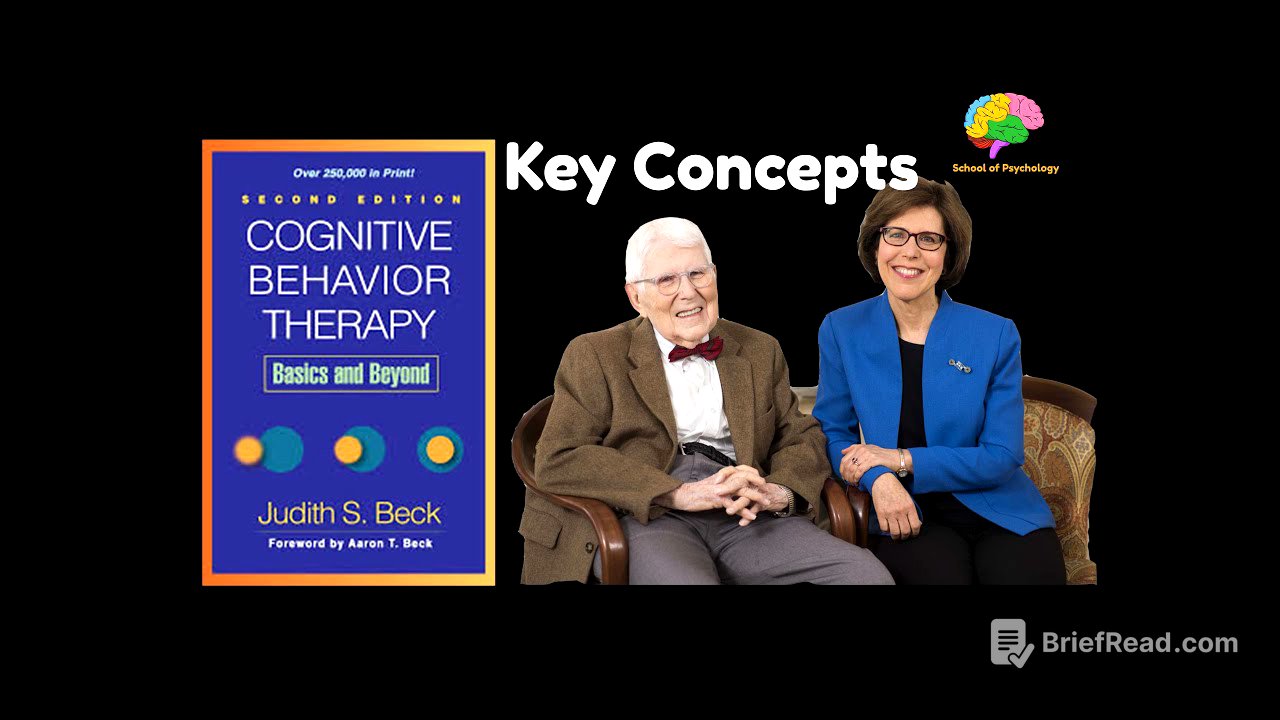TLDR;
This video provides an in-depth overview of Cognitive Behavioral Therapy (CBT), a popular and effective therapeutic approach. It explores the origins of CBT with Dr. Aaron Beck's research, its core principles such as individualized conceptualization, and the structure of a typical CBT session. The video also touches on practical techniques, the importance of the therapeutic relationship, and the role of homework in reinforcing skills learned in therapy.
- CBT is a mental workout that empowers individuals to understand their mental processes.
- CBT is not a one-size-fits-all approach; it's tailored to the individual's specific problems.
- CBT emphasizes the importance of the therapeutic relationship and continuous feedback.
Introduction to CBT [0:05]
CBT is presented as a popular, effective, and well-researched therapy that extends beyond the therapy room, offering tools applicable to everyday life. It emphasizes the connection between thoughts, feelings, and behaviors, empowering individuals to understand their mental processes and navigate life's challenges. CBT is described as a "mental workout" that enhances self-awareness and provides a toolkit for managing difficult situations. The discussion will cover the origins of CBT, its core principles, the structure of a session, and specific techniques, aiming to provide a straightforward and understandable overview.
The Genesis of CBT: Dr. Aaron Beck's Story [1:53]
The origin of CBT is traced back to Dr. Aaron Beck, who initially aimed to validate psychoanalytic ideas, specifically the notion that depression is hostility turned inward. His research, using dream analysis, unexpectedly revealed that depressed patients' dreams were dominated by themes of defectiveness, inadequacy, and loss, rather than anger. This finding challenged the psychoanalytic understanding of depression and highlighted the significant role of conscious thought processes. Beck's continued research challenged prevailing ideas, suggesting that people with depression did not necessarily need to suffer, paving the way for CBT as a new approach to addressing emotional difficulties by recognizing the impact of thoughts on feelings and behaviors.
Core Principles of CBT: Individualized Conceptualization [4:40]
One of the fundamental principles of CBT is individualized conceptualization, which means that CBT is not a one-size-fits-all approach but is tailored to each individual's specific problems. To illustrate this, the discussion uses the example of a woman named Sally, whose case a therapist would consider across three different time frames: her current thinking and behavior, precipitating factors, and predisposing developmental factors. By examining Sally's negative thoughts, behaviors such as isolating herself, triggers like moving away from home, and childhood experiences that made her vulnerable to depression, the therapist gains a holistic understanding of her experience.
Techniques and Diversity in CBT [8:43]
CBT involves a range of techniques beyond just talking, including cognitive strategies like Socratic questioning and guided discovery, as well as behavioral and problem-solving techniques. Therapists may also incorporate techniques from other therapies, such as Gestalt therapy or psychodynamic approaches, as long as they align with the cognitive understanding of how thoughts, feelings, and behaviors interact. The choice of technique depends on the individual's specific problem and the session's objective, making it a diverse and tailored approach.
What a CBT Session Looks Like [9:56]
A typical CBT session follows a clear structure, beginning with re-establishing the therapeutic alliance and checking in on the client's mood and recent experiences. Agenda setting is a key part, where the therapist and client collaboratively identify specific problems to focus on during the session. The session also involves reviewing self-help activities or homework and then diving into one of the problems on the agenda. Strategies to address the problem are planned collaboratively, and at the end of the session, there is a review to ensure clarity on homework assignments and to gather feedback from the client about the session.
The Complexity of Being a CBT Therapist [13:42]
While the core idea of CBT may seem simple, experienced CBT therapists manage many complex things simultaneously, such as understanding the client's situation, building rapport, educating about CBT, identifying problems, gathering information, testing hypotheses, and summarizing insights. New therapists often need to be more deliberate and structured, focusing on a few elements at a time while learning. Good counseling skills, such as building rapport, showing empathy, and actively listening, are essential for effective CBT, emphasizing the importance of the human connection.
The Importance of the Therapeutic Relationship [15:49]
Effective CBT relies on a strong therapeutic relationship built on trust, empathy, and active listening. Therapists demonstrate empathy through thoughtful questions, reflecting back what the client has said, and validating their experience. Continuous feedback is crucial, with therapists paying attention to the client's reactions, body language, and tone of voice, and addressing any signs of distress directly. Acknowledging and addressing negative feedback is also important for creating a safe space for honesty and collaboration.
A Snippet of a CBT Session with Sally [18:15]
The discussion presents a snippet of a CBT session with Sally, who is having trouble finding a part-time job. The therapist identifies Sally's automatic thought ("I won't be able to handle a job") and connects it to her emotions. The therapist then gently evaluates the thought by asking for evidence and reframing the situation, helping Sally to see things in a new light and brainstorm potential solutions. This collaborative, non-judgmental approach exemplifies the process of identifying automatic thoughts, linking them to emotions, examining evidence, and developing solutions.
Emphasis on the Positive in CBT [20:46]
CBT emphasizes the importance of focusing on the positive, especially when dealing with depression, as individuals with depression often have a tendency to focus on the negative. A CBT therapist will consistently work with the client to notice and attend to more of the positive aspects of their experiences, bringing balance and helping them recognize and acknowledge positive moments and achievements. This is not about faking happiness but about helping the client see the full picture and recognize the good in their life.
The Role of Homework in CBT [22:08]
Homework plays a key role in CBT, helping individuals apply what they're learning in therapy to their everyday lives. The goals of homework include evaluating and responding to automatic thoughts, devising and implementing solutions to problems, and practicing new skills. It is important to write down homework assignments, as automatic thoughts are most likely to occur when feeling down or distressed, when feeling the urge to do unhelpful things, or when noticing upsetting changes in the body or mind.
Beliefs and Cognitive Conceptualization in CBT [24:58]
Automatic thoughts stem from fundamental beliefs developed in childhood about oneself, others, and the world. These core beliefs shape how we see the world and interpret experiences, often operating unconsciously. The discussion uses the example of "reader E," who feels too unintelligent to understand CBT, to illustrate how a core belief of "I'm incompetent" can trigger negative automatic thoughts and emotional reactions. A cognitive conceptualization, represented by a diagram, shows the hierarchy of beliefs, from core beliefs to intermediate beliefs (attitudes, rules, assumptions) to automatic thoughts and emotional reactions.
Building the Cognitive Conceptualization and Initial Assessment [27:51]
The cognitive conceptualization is built from the first session and evolves continuously, with the therapist forming educated guesses based on the information shared by the client. The therapist checks with the client to ensure the understanding feels accurate and helps make sense of their experience. The initial assessment session is more than just getting a diagnosis; it has a lot of other goals.









